
Fresh Water at Sea Page Menu: 1 2 3 4 5 6 7 8 9 Next>>
Fresh Water at Sea in the Golden Age of Piracy, Page 2
Getting Fresh Water
Fresh water was such a necessity that sailors used a variety of methods to procure it for sea voyages. The most frequently used method for obtaining potable water has already been mentioned several times - bringing the casks or other containers and filling them on land when fresh water was found. Another way to get potable water was to collect rain while at sea, although this depended on the cooperation of the weather. Ships were also sometimes able to trade water. (Although, in the case of pirates, the trade sometimes ended up being a little one-sided.) Since a ship was literally surrounded by water, a few ingenious men even attempted to convert sea water into fresh. Let's look at each of these in detail.
Getting Fresh Water - Land-Based
The most frequently mentioned method for obtaining water was to gather it from springs, rivers or wells found on land. Many accounts suggest that ships stopped and loaded the water when it was convenient.
Getting Fresh Water - Land-Based Sources Free to Sailors
Some accounts suggest that procuring water was free and easy. George Roberts advised that while most
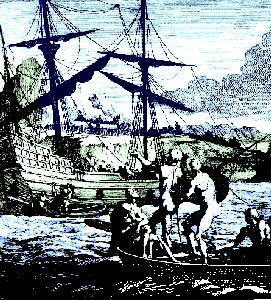
Natives Trading With a Ship, From Versameling der
Gedenk-waardigste
zee en Land-reysen na Oost en
West-Indien, Vol.15, p. 52 (1706)
English ships in the Cape Verde Islands stopped at Port Praya [Praia do Portinho, Santiago], the bay Rivira de Plata [Rebiera de Prata, Santiago] was clean and easy to anchor at with "the Water running down to the Sea-side, where you may rowl your Cask into the River, and fill your Water at the Bung [the hole in the middle of the cask], without using Bucket or Funnel."1
In some cases the local natives would actually helped the men get water for free. Dutchess captain Edward Cooke reported, "They [the natives in Mexico] are very honest, and would not take the least Thing without Leave; were willing to assist us in filling our Water, and supply’d us with whatsoever they could get; for which we fully satisfy’d them."2 When privateer George Shelvocke stopped at Puerto Seguro (modern Cabo San Lucas, Mexico) he noted that the natives just watched the men loading water at first. Eventually, "their natural compassion for the few of my men, whom they saw rolling of great casks of water over the heavy sand in the sultry heat of the day, enclin'd them to help us… they likewise roll'd our cask down to the boat, but always expected a white face to assist them, who, if he did but touch it with his finger, it was sufficient encouragement for them to perservere in their labour"3.
1 George Roberts, The Four Years Voyages of George Roberts, 1726, p. 411;2 Edward Cooke, A Voyage to the South Sea and Round the World in the Years 1708 to 1711, 1969, p. 321; 3 George Shelvocke, A Voyage Round the World by Way of the Great South Sea, 1726, p. 395
Getting Fresh Water - Land-Based Sources Costing Sailors
Other accounts mention potable water being purchased. Edward Cooke said that when they stopped to get fish and fresh water in Mexico they found "the Indians [were] furnishing all Necessaries for Money."1 When pirate Bartholomew Roberts was in Brazil, he found
fresh water very hard to come by. There, after "being fetch'd in Vessels from Olinda, [the water] will not be put on Board [a ship] in the Road [for] under two Crusado's a Pipe.
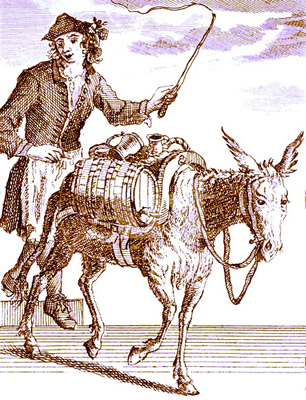
Artist: Marcellus Laroon
Vendor Selling Liquids, Cries of London Series (1688)
"2 While aboard the East Indiaman Sceptor, Edward Barlow noted that the water in Mocha, Yemen was "brackish [salty], yet extraordinary dear, paying near three shillings the ton; for they fetch it a long way off on asses’ backs in skins and bring it to the boat’s side."3 He warned that the locals sometimes inflated the bags used to carry the water with air to make it look like they were delivering more water than they actually were.
While loading salt at Boa Vista in the Cape Verde Islands, George Roberts explained "our Water also being almost expended we could tarry no longer; for you must know, that the Island of Bona Vist has no drinking Water but what lies a long Way up in the Country"4. He continued, noting that ships which came there for salt "must pay dear for that Water that must be brought down out of the Country by the Natives, on Asses Backs."5 He further said that ships taking cattle wouldn't bother to buy the water there "for your Cattle would drink it, in a manner, as fast as it could be brought down."6
Sometimes it was the fetching of the water which cost the most. When merchant sailor Thomas Phillips was at Cape Corso Castle (in what is now Ghana, Africa), water was filled at 'Domine's Hole', being rolled over stones from the water source "to the landing place, where negroes, who make it their profession and business, attend to swim the water-cask off to the long-boat, which lies about a cable’s length off shore at an anchor, not daring to come nearer for the great swell that constantly rolls upon this whole coast from the vast Atlantick ocean."7 After this, each man takes a "cask and swims after it, some times above water, sometimes under water, still pushing it forward before him till it comes to the longboat, who hoist it in... and for this service we pay the blacks so much a cask when we go away."8
Not paying the fine for water could result in official sanction. When sea surgeon John

Artist: Peter Casteels II - Port in a Fishmarket (Late 17th Century)
Atkins' was serving with the Royal Navy in 1721, they stopped in Guatemala to water where "John Conny, who is the principal Cabiceer [caboceer – government official], exalts [exacts] a Duty from all Ships, of an Ounce of Gold, for this Privilege"9. The men from the Swallow and Weymouth failed to pay the fee and mistreated the official sent to gather it. As a result Conny showed up "with a Posse and seize[d] our Water-casks ashore, carrying a way ten or a dozen of our Men Prisoners to his Town."10 After some negotiations, Conny agreed to accept 6 ounces of gold and 10 gallons of brandy for his trouble and released the men and let them get their water.
Not surprisingly, some officials tried to illicitly make money on a ship's need for water. On his voyage through the East Indies in 1699, William Dampier stopped at Fort Concordia on Timor Island where he arranged to get water from the governor. As he was lading water, the local Concordia-based officer overseeing his lading said they had to pay 'four Spanish Dollars' for each boat load of water being delivered to them from shore. However, as Dampier notes, in this he spake falsly, as I understood afterwards from the Govemour himself, and all his Officers, who protested to me that no such Price was demanded, but left me to give the Slaves what I pleased for their Labour"11.
Even pirates sometimes saw fit to purchase water. In October of 1691, an employee of the East India Company in Calicut, India was handed a letter while walking on the beach which read in part,
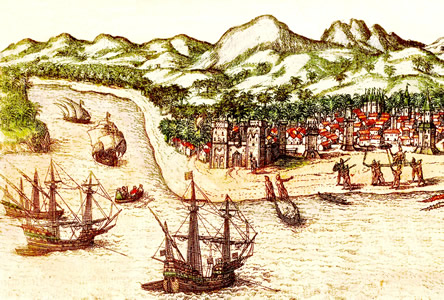
Calicut, India, From Civitates Orbis Terrarum, by George Braun & Franz Hogenbergs (1572)
"Though unknown to each other, yet being countryman I presume to write to you to lett you know that we design to clean our ship at your haven, and get some wood and water, as well as provisions for refreshing our men, for which we honestly design to pay as well as for one hundredweight of chunam (lime)."12 The letter went on to suggest (without actually stating) that they were pirates who were forced into that career by 'the troublesomeness of the times' and that they would be civil to them. It was signed 'Your Unknown Friend". Upon receiving no reply to the letter for a week a second letter arrived which stated "I now send this by the master of a ship which I intend to keep until I receive your answer whether to expect what I desire or not. Otherwise I shall come and take it."13 However, three large ships arrived at Calicut and scared the pirate off before he could make good on this threat.
In addition to the cost of purchase, water also sometimes had hidden costs. While in Macao, captain Alexander Hamilton mentioned that he "saw a fine clear Stream trickling down the Face of a Rock, about half a League (roughly 1-3/4 miles) from our Ship."14 However, since Hamilton was waiting for orders and they had nothing better to do, "I ordered my Men to fill about 20 Tuns of it, and being clearer than we had before, we made use of it, for drinking and boiling Rice."15 It would take a lot of work to move 5000 gallons 2 miles by hand.
Other obstacles presented hidden costs as well. On a stop to retrieve water in 1705, William Funnell explained that the location of the water required his men to fill small casks with water at the source, after which they carried it
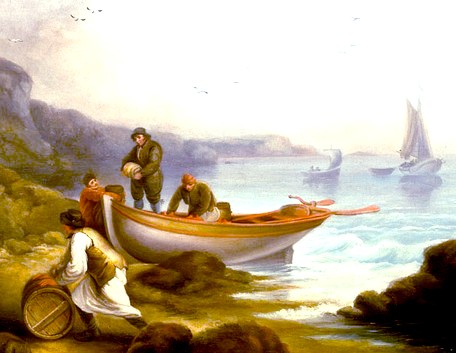
Artist: George Morland (1792)
up a hill "and there poured it into the Canvas-Pipe, which conveyed it down the Hill into our Cask. Thus we employed our selves for four days."16 While somewhat ingenious, the canvas pipe was likely custom made for this particular job, which was likely part of the reason it took four days. Other such engineering challenges will be examined in greater detail in section Problems with Fresh Water at Sea - Land-Based Procurement.
The amount of time such stops took away from the voyage is probably the largest hidden cost incurred. Pirate John Bowen missed meeting some of his fellow pirates as a result of "it taking up seven or eight days in watering their vessels, and settling their private affairs"17. Edward Barlow's diary contains the following 1685 entry: "our water growing short, and wanting refreshments, we went into Karwar [India] and there anchored and stayed a month"18. Now, in fairness, both these entries hint that getting water wasn't the only reason it took so long to depart, but the water was the reason they stopped in the first place. One problem with making landfall was that unforeseen issues could result in delays. This was particularly true of trying to round up all the sailors who had reached shore.
1 Edward Cooke, A Voyage to the South Sea and Round the World in the Years 1708 to 1711, 1969, p. 187; 2 Captain Charles Johnson, A general history of the pirates, 2nd Edition, 1724, p. 214; 3 Edward Barlow, Barlow’s Journal of his Life at Sea in King’s Ships, East and West Indiamen & Other Merchantman From 1659 to 1703, 1934, p. 482-3; 4,5,6 George Roberts, The Four Years Voyages of George Roberts, 1726, p. 9; 7,8 Thomas Phillips, 'A Journal of a Voyage Made in the Hannibal', A Collection of Voyages and Travels, Vol. VI, Awnsham Churchill. ed., p.204-5; 9,10 John Atkins, A Voyage to Guinea and Brazil, 1735, p. 75; 11 William Dampier, A New Voyage To Holland &c,, 1703, p. 28; 12 Charles Grey, Pirates of the Eastern Seas (1618-1723), 1971, p. 123; 13 Grey, p. 124; 14,15 Alexander Hamilton, British sea-captain Alexander Hamilton's A new account of the East Indies, 17th-18th century, 2002, p. 487; 16 William Funnell, A Voyage Round the World, 1969, p. 220; 17 Captain Charles Johnson, The History of the Pirates, 1829, p. 51; 18 Barlow, p. 371;
Getting Fresh Water - The Importance of Good Land-Based Sources
One of the reasons accounts were published was to provide other sailors and ship's captains with information on where they might find
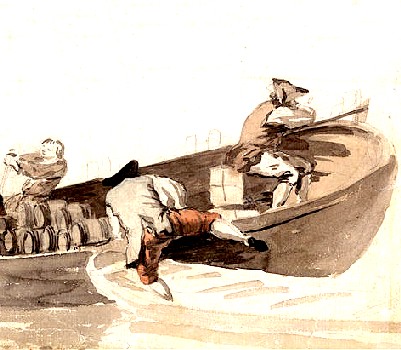
Artist: Samuel Scott - Men Loading a Boat with Barrels (18th c)
good locations for getting thins such as fresh food, potable water and the sturdy wood needed to replace damaged masts, spars and yards. Good water was of particular interest, as several authors' comments suggest. Buccaneer captain Bartholomew Sharp noted that "we found very good Water, and great plenty of Fish, Oysters and Muscles, with very good Plantains" in Honduras1, also advising that they "met with good fresh Water" at Ecuador.2 Buccaneer and surgeon's mate Lionel Wafer mentions that the Santa Maria River in Panama "has a fine Rivulet of very sweet Water: whereas those Rivers are brackish [salty] for a considerable way up the Country."3 During his privateering voyage, Woodes Rogers comments that they "found indifferent good [pretty good] Water on the N.E. side of the [Santa Maria] Island, which rejoiced us to be so unexpectedly supplied"4. The quality of water on Juan Fernandez Island is touted by both Captain Sharp, who says it has "three Springs of good Water"5 and William Ambrosia Cowley, who praised it for having "incomparable good Water"6.
A location which had both good water and ease of access were particularly prized. Edward Cooke stated that the Dutch settlement at the Cape of Good Hope had "excellent Water, which is fill’d at the Bridge with Ease, being brought thither in wooden Pipes from the Bottom of the Hill."7 Edward Barlow also recommends the Cape in a 1674 diary entry, listing a wide variety of foodstuffs which are grown there and ending it with, "Here is very good fresh water."8 Merchant sailor Samuel Atkins states that at Tangier, "Our boat came on shore, and watered at a most proper and convenient place, prepared for this purpose by Mr. Shere; the water extream good, and ye place such as may dispatch 20 boats in an hour."9
Captain William Symson, writing about his time with the East India Company beginning in 1701 even said that the company kept stations for wood, provisioning and watering their ships.

Engraver: Thornton - A View of the Town and Island of St Helena in the Atlantic Ocean
belonging to the English East India Company (c. 1790)
Discussing St. Helena, located about 1200 miles of the coast of Africa in the Atlantic, he said that the company found it "necessary to be at the Expence of keeping the Place, supplying the few Inhabitants with all Necessaries, because of the great Conveniency Ships find in so long a Voyage of touching there... for fresh Water", food and to prevent scurvy.10 Symson also noted that Anjoun Island in the Comoros off the east coast of Africa had "once made an Offer to the English to build there, and to make it a watering-Place for their Ships upon Occasion"11.
Occasionally, fresh water could actually be gotten at sea when a river flowed strongly enough from the land. William Dampier noted that when they were near the river Sungai Deli, which comes out near Belawan, Indonesia that the water was a 'muddy grey colour' but was sweet. So he "filled some of our Water Cask; and 'tis an ordinary thing in several places to take up fresh water at Sea, against the mouth of some River where it floats above the Salt-water"12.Woodes Rogers similarly advised that Plata River in Argentina "runs with such a mighty Stream into the Sea, as makes it fresh for a great way"14.
1 Bartholomew Sharp, "Captain Sharp's Journal of His Expedition," from William Hacke's A collection of original voyages, 1993, p. 51; 2 Sharp, p. 53; 3 Lionel Wafer, A New Voyage and Description of the Isthmus of America, 1903, p. 86; 4 Woodes Rogers, A Cruising Voyage Round the World, 2004, p. 272; 5 Sharp, p. 45;24 William Ambrosia Cowley, Cowley’s Voyage Round the Globe, from A collection of original voyages (1699) edited by William Hacke, p. 7; 7 Edward Cooke, A Voyage to the South Sea and Round the World in the Years 1708 to 1711, 1969, p. 429; 8 Edward Barlow, Barlow’s Journal of his Life at Sea in King’s Ships, East and West Indiamen & Other Merchantman From 1659 to 1703, 1934, p. 239; 9 Samuel Atkins, "A Sailor's Journal", Colburn's United Service Magazine, Part 1, 1854, p. 205-6; 10 Capt. William Symson, A New Voyage to the East-Indies, 1715, p. 11; 11 Symson, p. 13; 12 William Dampier, A Supplement of the Voyage Round the World, 1700, p. 156; 13 Rogers, p. 76-7
Getting Fresh Water - Land-Based Location Data
There are multiple references to places around the world where water was obtained by sailing vessels from sailors' accounts written around the time of the golden age of piracy. Using 38 different
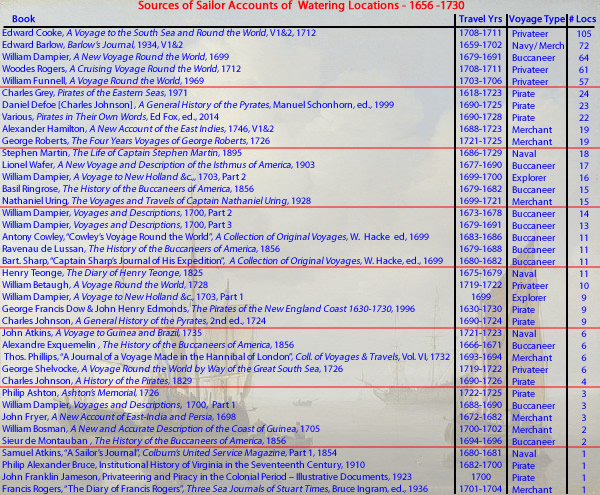
List of Authors Used to Generate Watering Locations Sorted by Number of Locations Mentioned
Image Artist: Willem Van de Velde the Younger - Ships in a Calm (c 1600)
accounts of voyages written by 32 different authors resulted in the gathering of 701 direct references to ships watering. See the chart at left for a summary of the accounts used which has been sorted by the number of places mentioned by each author.
This chart includes four things: 1) The author, book name and date of the book used, 2) The years during which the travel described took place, 3) The type of voyage(s) described in each book and 4) The number of times a location is specifically identified as being a place that the ship the author was aboard stopped for water.
These references have been restricted to those which mention places where mariners mention stopping for water. They exclude places where the gathering water is not specifically mentioned, although it almost certain that water was gathered at some of the stops mentioned even though it isn't specifically noted. For example, most accounts talk about stopping at places to refresh their "provisions" which likely included procuring water. However, when gathering water isn't specifically indicated, these locations have been excluded in the interest of keeping the data untainted. Sailors also sometimes mention locations where water might be found, but give no indication that anyone stopped there. Such locations are excluded from this list.
It should also be understood that the watering sites mentioned in most sailing accounts are do not typically list origins and destinations although there can be absolutely no doubt that nearly every ship would water before embarking on a long journey and gather whatever water it might need while in port on arriving. However, this is really a list of stopping points along journeys. As a result, there are only a few references to the logical watering in places where a voyage made an extended stay such as Holland, England, Barbados, Jamaica and the various English and Dutch colony destinations. Instead of these locations, the sailors writing during the golden age of piracy have provided us with a rich tapestry of temporary stops where water was gathered along the way from some place to another.

William Dampier's Maps of Panama & Parts of Central America,
From His Book Voyage Round the World, Facing Page 1 (1697)
These sources include a variety of different types of sailing ventures. Among them are eleven buccaneer voyages, seven books containing a wide variety of pirate accounts, seven merchant sailors' accounts, four naval accounts and two exploratory journeys. Because Edward Barlow's book is taken from his journal of 43 years at sea and he was in both naval and merchant vessels, he has been counted in both categories.
The type of voyage directly impacts the routes sailed during this period. Thus, different types of accounts tend to focus on different locations. The buccaneering accounts tend to focus on watering in Central and South America and the East Indies. The naval accounts often mention watering in Europe and the Mediterranean. The merchant accounts frequently focus on Africa and the East Indies. Dampier's two exploratory journeys were around Australia, New Guinea, Timor and the islands nearby. The pirates tended to water in the West Indies, northeastern South America, eastern Africa and the East Indies. Naturally, these are just rules of thumb; most accounts include locations outside those suggested.
There is overlap in some of these accounts. George Roberts' book takes place almost exclusively in the Cape de Verde Islands, with all nineteen of his watering suggestions being at various locations on six of the islands. Many of these are taken from a written tour of each major island which includes the mention of a variety of potential watering places. With this in mind, the total number of individual stops for water can be fairly reduced from 701 to 688. In addition, a few of the books included discuss the same voyages. This occurs with three sets of data: 1) Edward Cooke and Woodes Rogers accounts of Rogers' privateering voyage, 2) the various pirate accounts found in the books of Dow & Edmonds, Fox, Grey and Johnson, and 3) the buccaneering accounts of Sharp, Ringrose, Dampier, Wafer and Cowley (see the graphic below for details of how these five buccaneer voyages overlap). Removing the places where different authors mention the same stop further reduces the number of individual stops for water by a ship from 672 to 594.
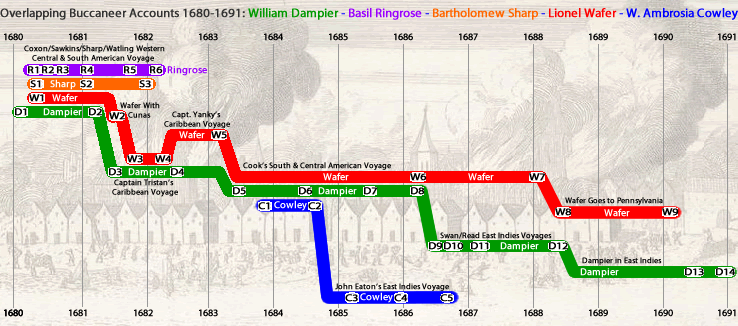 Overlapping Buccaneer Accounts - Where Lines are Close Together, Authors Are Traveling On the Same Voyage, Image 'The Sacking of Panama' from The Buccaneers of America by Alexandre Exquemelin, p. 29 (1678) Event Key - Basil Ringrose: R1: Privateering voyage begun in March, 1680 led by Captain John Coxon with Captains Peter Harris, (Frenchman) Bournano, Richard Sawkins, Bartholomew Sharp [Dampier on board], John Cook, Robert Alleston, Row and William Macket. R2:April 25th, 1680 John Coxon, leaves the group with 70 men. Richard Sawkins chosen leader. R3:Sawkins is killed in a skirmish at Puebla Neuba, Panama on May 22nd, 1680, Sharp is made leader. R4: Sharp deposed in early January 1681. R5: Deciding to return home, Sharp's crew reaches the Straits of Magellan, on October 12th, 1681. R6: They Land at Antigua January 30th, 1682. Ringrose reaches London March, 1682. Event Key - Bartholomew Sharp: S1: Sharp joins buccaneers in April 1681. S2: John Watling made captain in Sharp’s place in January 1681. Watling is killed three weeks later at Arica, Chile and Sharp is reinstated. S3: Sharp arrives in Nevis in January 1682, leaves there for England. Event Key - Lionel Wafer: W1: Wafer leaves Jamaica with buccaneers. They cross the Isthmus of Darien (Panama) in April 1680. W2: Wafer is wounded in the crossing of Darien on May 5th, 1681 joining the Kuna Indians on Panama during his recuperation. W3: When able, Wafer crosses isthmus and joins Wright’s crew (where Dampier is) at La Sound’s Key in late August 1681, serving under Captains Yanky and Wright. W4: Yanky leaves Wright at the Isle of Salt Tortuga in April 1682. Cook and Wafer go with him. W5: Cook and Wafer go to Virginia in February or March, 1683. W6: Wafer stays with Davis in sailing the Central and South American Coasts after Dampier leaves for two more years. W7: Davis sails around South America, returning to the Caribbean in early 1688. W8: Wafer joins Captain Edwin Carter in a Barbados Sloop, arriving in Pennsylvania in May 1688. W9: Wafer returns to England in 1690. Event Key - William Dampier: D1: Dampier leaves Jamaica with Sharp around Jan 1680. D2: Dampier leaves Sharp in April 17th, 1681 to cross Panama with Wafer. D3: Dampier and John Cook join French Captain Tristian’s ship on May 24, 1681. Sail to La Sound’s Key and meet other buccaneers including English Captains Coxon, Payne, Wright & Williams, Dutchman Yankey, Frenchmen Archemboe, Tucker and Rose. Dampier switches to Captain William Wright’s ship. D4: Wright visits Virginia in July, 1682. Dampier leaves Wright, staying in Virginia for 13 months. D5:John Cook organizes a buccaneering voyage in the ship Revenge on August 23, 1683. Dampier, Edward Davis and Lionel Wafer go with him from Virginia. D6: Cook dies in June 1684 at Cape Blanco. Edward Davis takes command. D7: Meet with other buccaneers in May, 1685 including English crews Davis & Swan, French crews Towley & Gronet, French and English crews Harris & Branly. D8: Dampier tires of buccaneering in South and Central America, joins Swan on the Cygnet leaving for the East Indies in March 1686. D9: Swan and Dampier arrive in Guam in May, 1686. D10: Swan arrives in Mindanao, Philippines in late June, 1686. D11: Swan’s crew mutinies at Mindanao, making John Read the captain of the Cygnet planning to plunder the East Indies. They force Dampier to go with them, leaving January 1687. D12: Dampier is left by request on Nicobar in May 1688. He goes to Achin. D13: Dampier becomes the gunner at Fort Bencouli in Sumatra sometime after July 1690. D14: Dampier leaves Bencouli on the Dutch ship Defence under Captain Heath on January 31, 1691, heading for England. Event Key - William Ambrosia Cowley: C1: Cowley joins Cook's voyage in September, 1683. C2: Cowley leaves Cook in August 1684 joining John Eaton to sail to the East Indies. C3: Cowley arrives in Guam on Eaton’s ship in March 1685. C4: Cowley leaves Eaton around Dec 1685/Jan. 1686. Joins a ship headed for Holland at Batavia around Feb/March 1686. C5: Cowley returns to England by October 1686. |
Although the names of the cities and countries mentioned in the texts are obviously from the period the book was written, their locations have been translated into their modern equivalents (as of 2019). The locations includes watering stops in 66 different modern countries with the number of stops in each country shown in
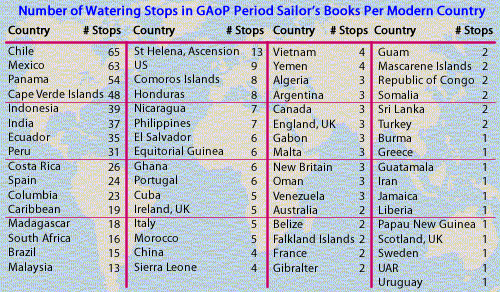
List of Authors Used to Generate Watering Locations Sorted by Number of Locations Mentioned
Image Artist: Willem Van de Velde the Younger - Ships in a Calm (c 1600)
the graphic at left. Considering that these accounts are restricted to countries with coastal areas, this is a fairly significant portion of the countries in the modern world. Given the large number of buccaneer and pirate accounts included in this data, it should not be surprising that the top three countries are in Central and South America. The next is the Cape Verde Islands, which is inflated George Roberts' extra 13 mentions of them. Other than Spain, the top 10 most visited countries are from South and Central America and the East Indies. The East Indies were popular destinations for merchants and, by association, pirates.
Although the data is not presented here in chart form, the most popular cities roughly agree with this data. The top eight most visited cities are:
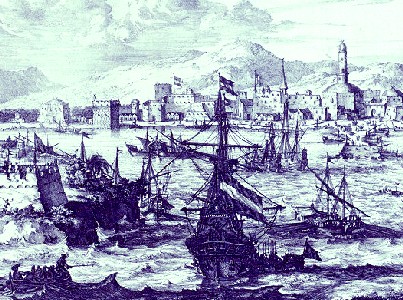
Artist: Olfert Dapper - Dutch Factory (Warehouse) Off Mocha, Yemen (1680)
1. Juan Fernandez Island, Chile (22 stops)
2. Santiago, Cape Verde Islands (16 stops)
3.
St. Helena Island in the Atlantic (11 stops)
4. Cape of Good Hope, Africa (11 stops)
5.
Isla de Coiba in Panama (11 stops)
6. São Vicente. Cape Verde Islands (10 stops)
7.
Isla Gorgona in Columbia (9 stops)
8.
St. Augustin, Madagascar (8 stops)
Once again, the Cape Verde Islands may be overweighted because of Roberts' book. For reference, the next four most popular places to water in this data are Isla Maria Madre, Mexico, Cabo San Lucas Mexico, Altea, Spain and Ilha Grande, Brazil, each location having seven stops. The South and Central American influence of the buccaneers is clearly visible here. However, it is also notable that the Cape of Good Hope, Cape Verde Islands and St. Helena were all considered good watering stops for ships heading around Africa to the East Indies.

